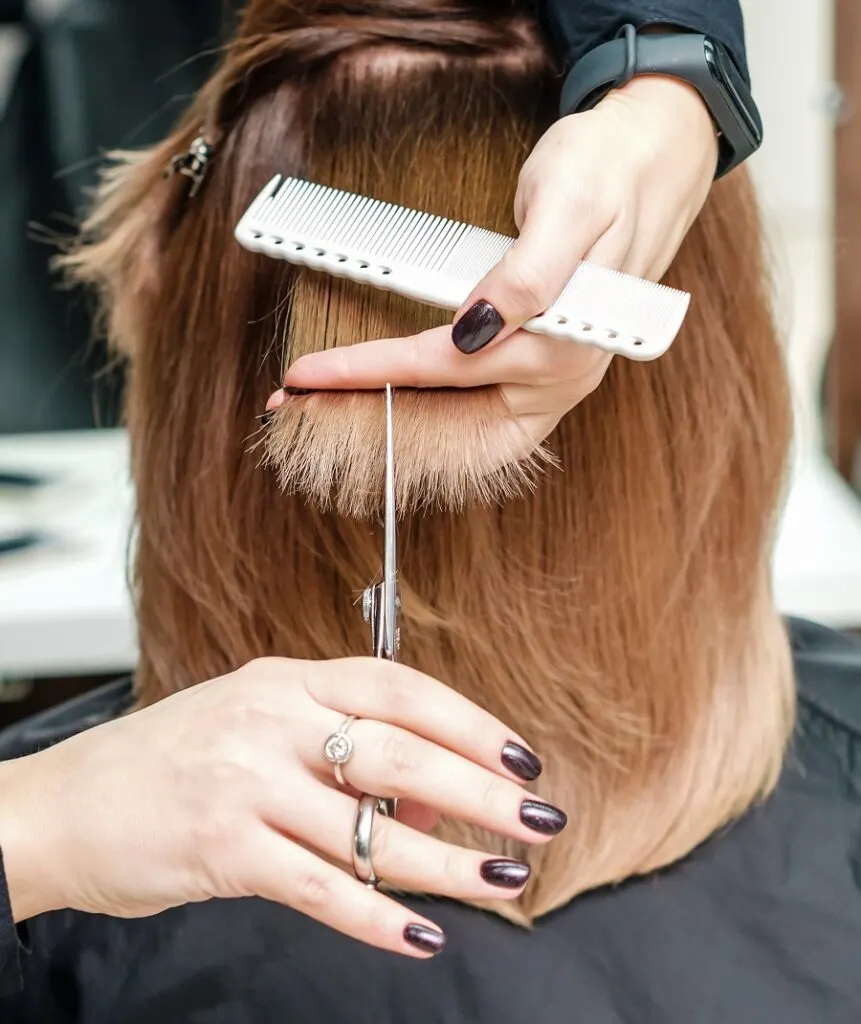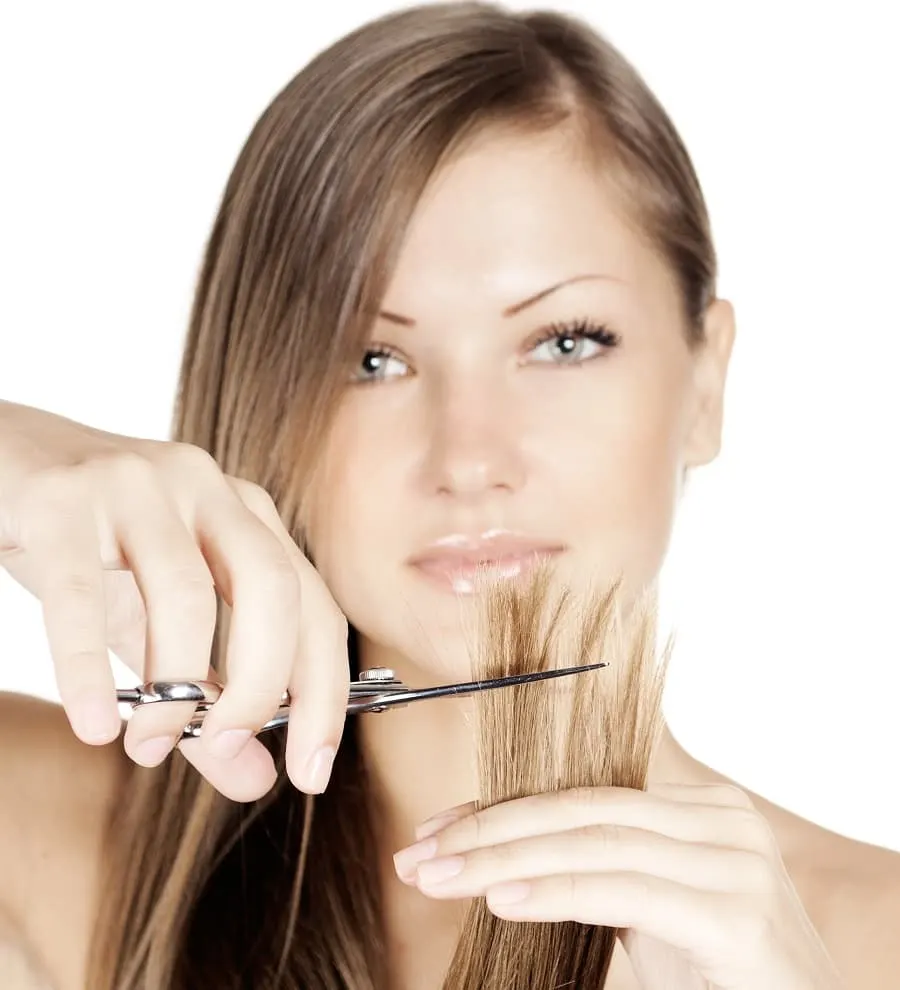We’ve all been there, you go into the salon to get a trim and come out with a bob instead. However, split ends are unavoidable even with heat protectants, hair masks, and detangling brushes; those pesky ends will pop up eventually no matter what we do.
So how do we get rid of our split ends without losing lots of precious length off our hair? The answer is hair dusting!
We’re here to talk about hair dusting, our favorite technique to kiss split ends goodbye without having to cut the length off of our ends.
Hair dusting is our secret to keeping our hair healthy and long and we want to share everything we know about it so you can add hair dusting to your hair maintenance routine!
What Is Hair Dusting?

Hair dusting is a technique used in hairstyling that involves the careful trimming of the hair ends to remove only the damaged or split portions, leaving the healthy hair intact.
The term “dusting” comes from the fact that only a small amount of hair is trimmed, resulting in tiny “dust” particles of hair falling away.
Hair dusting differs from a hair trim because it should take less than a quarter inch of hair off the length (next to nothing!) and will focus mainly on getting rid of the split ends strand by strand. Hair dusting looks to remove those obvious frayed ends that can look like flyaways or dry pieces.
How Is Hair Dusting Done?

Hair dusting should be performed on sleek, blow-dried hair as this allows the stylist to easily identify all the split ends.
This involves the stylist meticulously combing through your hair, selecting very small sections at a time. These sections are then tightly twisted to expose every strand of hair that is frayed or in poor condition and thus needs to be removed.
Once your hair has been twisted and the split ends have been exposed, your stylist will make use of extremely sharp shears. With these, they will rapidly snip off all the tiny hairs protruding from the twisted sections.
This process will be repeated throughout your hair until all sections have been thoroughly inspected and all damaged ends removed. The end result should be a head of hair that appears healthier and shinier, free of any split ends.
Remember, while you can attempt this at home, it’s usually best to have this done by a professional to avoid accidentally cutting too much hair.
Can You Do Hair Dusting At Home?
You can but be sure your hair texture will allow you to easily do hair dusting at home. Smooth, fine, or wavy hair types will be easy to do hair dusting on at home because these hair types make it easy to see split ends on the hair.
Coarse and curly textures can make it harder to see split ends and you may accidentally remove hair that isn’t damaged.
Also, make sure you have the proper shears for hair dusting. This means shears that are meant for haircutting and are very freshly sharpened!
If you move forward with hair dusting at home, follow our steps from the “How hair dusting is done” section of this article. There are also many tutorial videos available online to show you first hand how to dust your hair at home!
Who Is Hair Dusting For?

Hair dusting is perfect for those who have long hair and don’t want to lose any length or those who are trying to grow out their hair from a shorter cut.
Remember that split ends move up the hair and can cause breakage over time, that’s why removing them regularly with hair dusting will help keep hair long by preventing breakage and making the need for bigger trims less necessary.
Removing split ends is the only way to fully get rid of them, there aren’t products out there that can repair or heal split ends so hair dusting is truly going to be a long-haired girl’s best friend.
How Often Should You Get Hair Dusting Done?
About every 8-12 weeks is ideal for hair dusting (about the same timing as a trim), keeping up with hair dusting will allow you to go longer between bigger haircuts.
Hair dusting is normally less expensive than a trim or haircut in the salon and is much quicker, you can also do it at home like we talked about before!
Getting hair dusting done on a regular basis should be relatively easy and wallet-friendly hair maintenance.
If you haven’t already embraced hair dusting we hope this article has convinced you to do so! We absolutely love it for maintaining hair length and health.
Removing split ends from long hair will make it easier to style, and brush through and most importantly it will look its absolute best!
Benefits of Hair Dusting
Here are some of the benefits of hair dusting:
- Stops split ends from progressing, promoting hair growth and enhancing shine.
- An easy at-home alternative to regular trims, saving both time and money.
- Eliminates troublesome split ends without compromising on hair length.
- Acts as a tune-up for your locks, cleaning up ends that are beginning to split, without losing length.
- Less costly than a full trim, maintains hair smoothness, and prevents future hair breakage.
Hair Dusting Vs. Traditional Haircut
Hair dusting and traditional haircuts serve different purposes. Traditional haircuts change your style or length, while hair dusting keeps your length and focuses on health by removing split ends. You can do hair dusting at home, making it cost-effective and convenient.
But, it might not be suitable for all hair types, particularly very thick or curly hair, as spotting split ends can be challenging. Dusting also requires patience and precision to avoid causing more damage.
So, choose based on your hair needs – a new look calls for a haircut, and maintaining long healthy hair calls for dusting.
| Hair Dusting | Traditional Haircut | |
|---|---|---|
| Purpose | Focuses on maintaining hair health and eliminating split ends without sacrificing length. | Intends to change hair length and style completely. |
| Length of Hair Removed | Minimal – only the split ends are targeted. | Depends on the desired style, but usually more than an inch. |
| Frequency | Can be done in between regular haircuts or as often as you spot split ends. | Typically recommended every 6-8 weeks, depending on your hair’s growth and style. |
| Suitability | Best for smooth, fine, or wavy hair types where split ends are easily identifiable. | Works for all hair types and lengths. |
| DIY-Friendly | Can be done at home with some practice and the right tools. | Requires professional skills for most styles, so DIY might not always be feasible. |
| Cost | Generally less expensive since it requires less work and can be done at home. | More expensive due to the level of expertise and time needed. |
| Effect on Hair Health | Promotes hair health by preventing further split ends and breakage. | While it can get rid of damaged hair, it doesn’t specifically target split ends. |
How to Care Your Hair Post-Dusting
Maintaining the health of your hair post-dusting requires a mindful approach towards hair care routines and habits. Here’s how you can ensure the longevity of your dusted locks:
- Choose a mild shampoo: Opt for a sulfate-free shampoo. It’s gentler on your hair and preserves natural oils, helping avoid further hair damage or split ends.
- Use a conditioner: It’s essential to keep your hair moisturized. Applying conditioner, mainly to the hair ends, helps seal in moisture and provides a layer of protection.
- Invest in a leave-in treatment or serum: These products offer extended nourishment and defense for your hair. Search for treatments that are specifically designed to target and prevent split ends.
- Minimize heat styling: Overuse of heat styling tools like hairdryers or curling irons can lead to hair damage and more split ends. If possible, let your hair air dry and always use a heat protectant when you need to style with heat.
- Stay hydrated and eat healthily: Drinking sufficient water and consuming a balanced diet rich in protein, vitamins, and essential fats can boost your hair health from within.
- Avoid harsh chemical treatments: Procedures like coloring or perming can cause significant hair damage and result in more split ends. If you decide to have these treatments, make sure to amp up your hair care routine afterward.
- Switch to a silk pillowcase: Silk pillowcases can reduce friction on your hair during sleep, which can help prevent split ends and other damage.
- Schedule regular dusting sessions: Regular hair dusting helps maintain your hair health and length over time, especially if your hair is prone to split ends.
Key Things to Remember:
- Hair dusting is the best way to get rid of split ends without losing any of your hair’s length
- It’s great for long-haired ladies and those who want to grow out a shorter haircut
- Hair dusting is done on smooth, blow-dried hair. Your stylist will twist sections of hair revealing split ends and then use shears to cut the split ends away.
- You can do your own hair dusting at home but be sure you have a hair type that will allow you to do this easily
- Hair dusting should be done every 8-12 weeks
